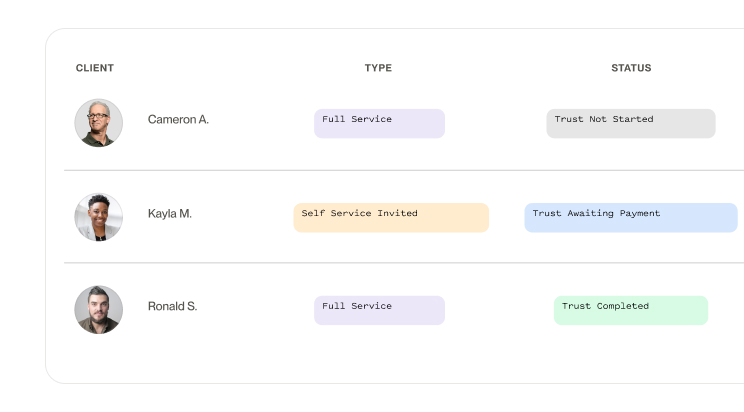The $124 trillion "great" wealth transfer is here

We’re still early in what could be the biggest transfer of wealth in modern history. Advisors who lean in now will help shape the next era of financial planning—not wait to catch up to it.
Cerulli Associates projects that roughly $124 trillion will pass to heirs and charities by 2048. Nearly $100 trillion of that—roughly 81%—will come from Baby Boomers and older generations. For financial advisors, estate planners, and institutions, this isn’t just a stat—it’s a 25-year shift that’s going to reshape everything: how we build client trust, how we deliver services, and how we define “protecting family wealth” in a multi-generational world.
At Estate Guru, we don’t see this as a future issue—it’s already unfolding. And for advisors, it’s an open door to lead. The implications of the Great Wealth Transfer are massive. Advisors who act early will have the advantage—clearer relationships, stronger loyalty, and a long-term edge.
The 2026 Tax-Law Sunset: A gifting deadline with real stakes
The current federal estate and gift tax exemption is around $13.6 million per individual through 2025. But on January 1, 2026, that figure is set to fall to roughly $7 million unless Congress renews the Tax Cuts and Jobs Act. For married couples, that shift would reduce the combined exemption from nearly $27 million to about $14 million.
For clients approaching those thresholds, now’s the time to evaluate options—accelerating gifts, funding trusts, or adjusting asset structures. Acting before the sunset could mean millions in tax savings later.
What’s unfolding isn’t just a shift in money—it’s a transfer of financial decision-making on a historic scale.
In the next 25 years, heirs are set to receive $105 trillion, while $18 trillion will move toward charitable causes. More than half—$62 trillion—is expected to come from high-net-worth and ultra-high-net-worth households, which make up just 2% of all U.S. households. And before it even reaches the next generation, $54 trillion will move between spouses, much of it from older partners to surviving widows.
Nearly $40 trillion is expected to go to women—many of whom will be stepping into financial decision-making roles, often for the first time. This is more than a line item on a balance sheet. It’s a shift in leadership that will shape the future of wealth management. Advisors who approach it with short-term thinking will miss the bigger opportunity. The ones building long-term trust will stay in the picture.
Women and wealth: A strategic inflection point
An estimated $40 trillion is expected to pass to widowed women—much of it from Baby Boomer spouses—marking a major shift in household financial leadership. Many of these women will be taking full control of family wealth for the first time. And while their priorities often differ from those of their late partners, they tend to place greater emphasis on planning, charitable giving, and long-term advisor relationships.
Studies show that nearly 70% of widows change financial advisors after a spouse’s death. That’s a clear signal: building trust before the transition happens is critical. Bringing both partners into the planning process isn’t just thoughtful—it’s smart strategy.
Effective communication makes the difference. Advisors should offer clear guidance, consistent touchpoints, and planning options that reflect personal values—especially during moments when clients are making high-stakes decisions in emotionally complex circumstances.
Gen X will inherit first. Millennials will inherit more.
While Millennials are expected to receive $46 trillion overall, Gen X is projected to gain $14 trillion by 2035. That shorter timeline brings urgency. The chance to connect with these rising decision-makers is already here—and advisors who delay may not get a second one.
Advisors who wait until wealth transfers are already at a disadvantage. When a primary client passes and there’s no connection to the family, assets often follow them out the door. According to Cerulli, 89% of top high-net-worth firms are prioritizing family meetings and generational planning—not as an add-on, but as a core part of retention.
Estate planning offers a natural entry point. It’s timely, emotionally relevant, and often brings families together at a moment when they’re already focused on the future.
What advisors can do right now
For advisors working with Baby Boomers, now is the time to connect with the wider family. For those advising Gen X, the focus is on elevating strategic value. And firms aiming to grow with Millennials need to offer clear, digital-first service built around trust.
Many of today’s most proactive advisors are already:
- Hosting family-focused estate planning sessions
- Using low-friction will and trust creation to deepen relationships
- Collaborating with attorneys via integrated tools like Estate Guru
- Offering tax, charitable, and legacy education across generations
- Building long-term continuity into every plan to protect AUM
Success over the next 25 years will depend on more than managing money. The advisors who thrive will be those who build durable, multi-generational relationships rooted in trust and long-term strategy.
Closing thoughts: This is your moment to lead.
The Great Wealth Transfer isn’t just about capital—it’s about expectations. Over the next two decades, advisors will face a clear test: Can they deliver estate planning that’s integrated, accessible, and built for entire families?
Modern wealth demands a modern approach. Today’s families face complex realities—blended households, shared assets, and multi-generational priorities. Traditional tools weren’t built for this. Generic documents and outsourced legal work can’t keep up with what clients actually need.
Estate Guru is designed to meet that complexity with flexibility. The platform embeds legal expertise directly into the advisor workflow, allowing you to offer compliant, state-specific planning without losing ownership of the client experience. From wills and trusts to healthcare directives and powers of attorney, every document is supported by built-in legal guidance and shaped to fit how advisors already work.
This is not a bolt-on solution. It’s a legal foundation—flexible, collaborative, and built to scale alongside the evolving needs of modern practices.
For advisors ready to lead, the opportunity is wide open.
Keep assets, earn loyalty, and stay relevant for decades—schedule your demo here
.svg)


.svg)
.svg)


.png)


